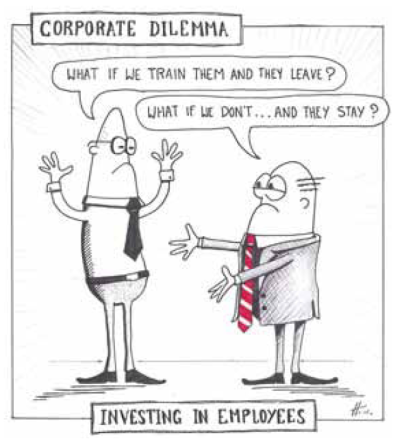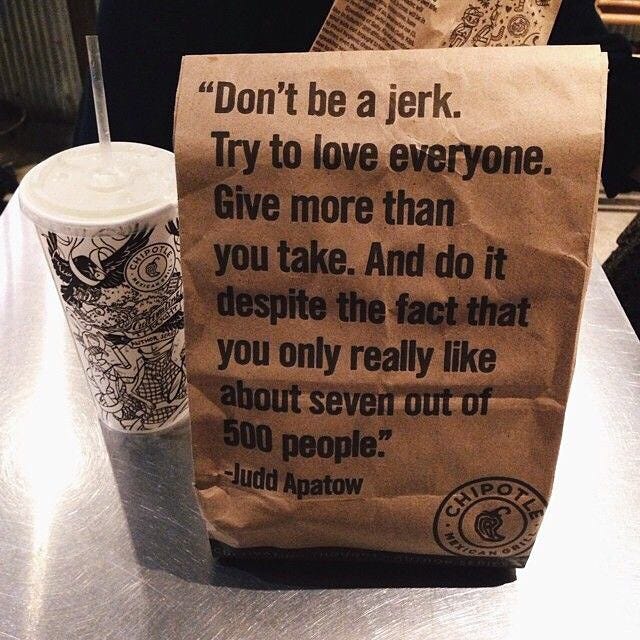Investing in our people
Big Ideas | Leadership | Professional Development | People Operations | Human Resources
A pathway for confronting the cultural sector’s challenges
The health of the cultural sector, and its ability to be creative, innovative, and resilient depends on the quality and skills of the people working for our organizations. In order for our sector to remain vibrant and relevant, we need to continually develop and leverage the skills our people possess.
A couple weeks ago, the Fractured Atlas staff sat down for pizza with finance guru Barry Ritholtz. He joined us for our monthly Visiting Professional Series, and as Barry spoke about managing personal assets so that they will grow to take care of us later in life, I couldn’t help but think about parallels with how our organizations grow and invest in (or don’t) our human assets.
A friend of mine once said that it’s not like arts organizations are sitting on assets that passively generate tons of cash thereby allowing them to do stupid things. Our assets are our people. How we manage and develop these assets has a direct impact on our ability to deliver results and fulfill our missions.
In the cultural sector, we hear a lot about organizational strategic plans, but very little about human resource strategy and people planning. Managers having active and regular career development conversations with their people, and leaders infusing organizations with a culture of learning is a rarity, not the norm. The very ability to deliver on those strategic plans is directly linked to the people you have helping you execute the plan. Ignore this at your organization’s own peril.

I love this cartoon. It captures an all-too-frequent sentiment when the topic of staff development is raised. What if we invest time, energy, and money and our people still leave? Well, you’re in luck! Staff are already thinking about how much their company is investing in them regardless of whether or not managers acknowledge it. Let’s just say it now, everyone will eventually leave. That’s not a valid reason not to invest in them.
Our staff members are with us for but a short time as everyone eventually moves on for other opportunities. This is a good thing! While this “churn” can cause anxiety in the short-term, it’s ultimately good for our organizations and our sector. It allows us to continually cultivate the diversity of thought and talent on our team. It spreads new information and new ways of doing things from organization to organization. And, it allows us to build and refine our team for the challenges we face today, not those that we faced two years ago, or ten years ago, or yesterday. Our responsibility to our companies, our people, and our sector, includes seeing that we are good stewards of the assets we’re granted for the time we have them in our care.
“Learning to earn a paycheck” is not a viable staff development strategy
Staff should not bear this development burden alone. Nor is “we’ll train you for the job” (i.e., here’s your computer, access to the file server, and directions to the restroom) an adequate response to proactively helping staff develop new skills, to exposing them to new ideas that broaden their perspectives and make connections beyond our sector, and to helping them “level-up” their career prospects.
I recently read of a manager who asks her staff to bring their updated resume to their annual performance review. If while reviewing it with them she realizes that they haven’t added anything new to it in the past year, she sees that as a managerial failing — not theirs — for not helping them identify and develop new skills and opportunities for growth.
“With skill development today there is no standing still. You’re either moving forward or you’re losing ground.”
We can’t expect to simply outsource this function either and get meaningful results that will be beneficial and bespoke to our organization’s current needs. It’s a combination of efforts that will create an effective staff development environment.
What does a culture of learning and staff development look like?
Each organization is unique, so what works for one of us won’t necessarily work as a carbon copy for another. We can’t all just copy Google’s playbook on this and expect it to work “as is”. What shouldn’t be unique is having a willingness to be creative and experiment with options, and then share what works and what doesn’t so we can all benefit.
Please don’t think that in writing this post I’m doing so claiming Fractured Atlas has figured out the key to this, even for us. We’re constantly testing, iterating, nixing, and trying different offerings. Some things work for a while, some things fizzle out immediately, and some things have been with us since the beginning. Below are a few examples of the things we’re currently doing on this front.
Please let me know what’s working for you and your team. And by all means, if you think something below might be of interest to your crew, don’t hesitate to borrow and iterate on any of these ideas.

Visiting Professional Series
How many of your people have a chance to interact with senior-level executives who work primarily outside of the cultural sector? Maybe your Executive Director and Development Director as they cultivate donors from this cohort and work with your board of directors? It’s probably not everyday that your administrative assistant has the opportunity to have lunch with the CEO of a New York Stock Exchange-traded company.
The Visiting Professional Series was born out of that very thought. How interesting might it be to have all of our people sit down with a senior-level executive who they typically don’t have an opportunity to meet? Let’s give staff the chance to ask her questions about how she got to be where she is today. What advice she would give her younger self. Talk about how she approaches challenges that transcend sector (i.e., balancing the urgent versus the important, recharging her energy, etc.). About every month or so we host a VPS lunch. It’s a sit-down pizza lunch in the conference room where we explore these questions. Each time a different staff member serves as the moderator for our conversation to get things kicked off and keep them flowing.
“Even big-time CEOs love pizza.”
Our guests have included, among others, the Global External Relations Officer for Procter & Gamble, Co-founder and CEO of The Motley Fool, CEO & Chairman of Arbitron, Chief Investment Office for Xerox, former 6-term U.S. Representative, and the now Director of Corporate Responsibility for Amazon.
We recently started inviting our board members as featured guests in the Better Know A Board Member version of VPS. If you don’t know where to start, ask your board chair to kick things off. Then ask your board members if they can recommend any interesting candidates from their networks.
(#ProTip: Buy a bottle of wine as a thank you gift for your guest. In advance of the visit, use a silver Sharpie to write “Thank You, [First Name]” on the bottle and then pass it around the office for each person to sign the bottle too. Turns a simple gesture into a meaningful momento. Also, makes it harder for the person to re-gift.)

May the task force be with you
When we’re kicking around new ideas that we think might have legs, or a finite lifespan, or it doesn’t live in any one person’s domain, we’ll form a cross-organizational task force to dig in and explore it. Some companies have “20% time” where staff can use a few hours a week to work on projects outside of their “assigned” portfolio. Our task forces are more like 5–10% time. They bring together people from around the organization who don’t typically have a chance to work together on a project. Task forces also often afford staff who are earlier in their career with opportunities to develop and exercise leadership skills by chairing the group.
After a lot of trial and error, we’ve landed on some guidelines for defining the scope and specific purpose of a given task force, how long it should meet (a never-ending task force with a broad scope can be more demoralizing than energizing and effective), how many people should serve on it, and how to document the findings in case at the end of the process we shelf the idea but want to resurrect it later on. Right now we have a couple of different task forces in operation: for R&D projects (e.g., Make Time Clock and the #ArtStartUp card game), for our Arts Entrepreneurship Awards, to explore a podcast, and to create our Fractured Atlas brand book. More recently task forces have spawned “jam sessions”. Jam sessions are essentially smaller and shorter-lived versions of task forces.
For the most part, both task forces and jam sessions are scheduled whenever the group of people can find time, and we typically don’t provide any money at the onset. If something looks like it might work, we give the group a couple of dollars to take it to the next level. Then a few more dollars if it continues to be promising. If not, we wrap things up and move on. There are countless ideas we want to explore. If something isn’t panning out, move on and put something else in the queue.
Next time someone floats an idea that might be worth exploring and your knee jerk response is, we don’t have the time to look into it, ask yourself if this might be just the thing for a task force to tackle. The organization’s next big thing might come out of it.

Musical chairs
Here’s an easy one. Rotate the person who chairs your full staff meeting. Open it up to any interested person in the company and schedule slots on a first-come, first-served basis.
Learning to chair an effective and efficient meeting is a skill that needs to be developed. Few are just “born with it”. Don’t just keep having the same person/people who can do it really well chair your meetings. It helps the organization, and the field, so much more if we have a whole host of people who have developed the chops to facilitate an effective meeting.
Like any good delegator, you might want to spend time with the designated person before the meeting to review some pro tips and help them pre-game what they can do if things go sideways on them. Also, like any good delegator, if things do slide sideways on them during the meeting, bite your tongue and don’t immediately rush in to save them. Give them a moment to wallow in the awkwardness and see how they choose to address it. In the long run, it’s better for them to develop these muscles in a setting among friends who are rooting for their success versus one where the crowd might not be as supportive.
(h/t to friend Russell Willis Taylor, most recently the President & CEO of National Arts Strategies for this piece of advice.)

Can I have an allowance?
Every staff member at Fractured Atlas receives a $1,000 professional development allowance each year that they can spend on pretty much anything — within reason — to develop their skills and knowledge in order to grow in their position and career.
We started offering the $1,000 allowance when there were only a few people on staff and we had a budget well under $1M. We’ve kept at it all these years, even as the staff has grown to number 35. When budget season comes around this isn’t an elective item. It’s treated like any other form of compensation. Often times other items in the draft budget need to be pared back or cut in order to continue offering it at the $1,000 level.
While I’m particularly proud that we’re able to offer an allowance at this level, I understand that $1,000 per person is a chunk of change that not every organization can commit to doing. If you’re not offering anything right now, even $50 can be a meaningful amount. It shows that you want to invest in your people and their future. Note: You can’t be fair weather about this though. You can’t add it this year and take it away next, even if people don’t initially use it. (See Active Career Conversations below)
Over the years, the Fractured Atlas staff have spent the annual allowance on a myriad of things. Continuing education classes, Lynda.com memberships, memberships to professional organizations like SHRM and Association of Fundraising Professionals. They have spent it to attend conferences that they otherwise wouldn’t attend because it falls outside of their position (e.g., an Administrative Assistant attended Nina Simon’s Museum Camp one year). People spend it on webinars, to attend seminars, and to pay a public speaking coach.
We have one guiding rule and that’s that the allowance can be used to purchase software but not hardware. You can buy the book for your Kindle, but you can’t buy a Kindle. The allowance is also use-it-or-lose-it and doesn’t roll over from year-to-year. So, as the end of our fiscal year approaches there’s a noticeable uptick in the number of Harvard Business Review and Learning to Code books arriving daily from Amazon.com.

Authorship for everyone!
Does your organization have a blog or a newsletter? Is everyone encouraged to author posts for them? If not, remove the firewall and start encouraging your people to pitch and develop content for those platforms. Work with them as they hone their craft, find their voice, and develop their following.
Maybe you have a staff member who loves reading and wants to create an online book club like my coworker Nathan did on the Fractured Atlas blog. Or you have a handful of staff members in your organization who want to contribute to a regular Tips & Tools column. Encouraging authorship at all levels of the organization not only develops staff members’ skills, but it also creates a diversity of thought and opinion for your readership to enjoy.
Active career conversations
This is one that pops up to varying degrees in many professional development offerings. It’s important enough though that I want to call it out here.
My friend, the late Dr. Jack Watters, once said that you can’t ignore having active career conversations with your staff. It’s not like if you don’t have these conversations your people will all of a sudden stop thinking about what they’re doing in life and how their work is, or isn’t, helping them get to the next level.
Sit down with your people on at least an annual basis to talk with them about their longer-term professional goals. Discuss what it is you and your organization can do to help them progress towards those goals. Then finally, how they can spend their professional development allowance to help grease the skids to get things moving.
Sometimes the next steps are easy. This book is great and exactly what you’re looking for. Or, you should talk with Linda over in accounting. She’s an expert in that and can point you in a helpful direction. Other times it’s more difficult. Like when you’ll likely lose a great person sooner than you want. So you want to go to grad school or start your own company? Well then, let’s make sure that we help you be as ready as possible for when that day finally comes.

Brown Bag Lunches
Did someone in your company just return from an interesting conference or complete their dissertation? Has someone been noodling around on a fun side project? Why not encourage them to share their learning during an attendance-optional brown bag lunch?
Use Brown Bag Lunches to encourage knowledge transfer and learning. Offer staff the opportunity to practice and refine their presenting skills. Enjoy each others’ company when not “talking about work.”
Some of our recent Brown Bag Lunches have included presentations from Adam Huttler about his time at Singularity U, Chap Ambrose sharing his concept for what became our R&D product the Make Time Clock, and a film screening with Fractured Atlas member and director Kevin Newbury.
Let’s Learn Together
Want to take Brown Bag learning to the next level? Encourage your people to create and teach classes for interested staff members. Google has an entire course catalog populated with employee-to-employee courses. Want to learn the secrets to superior spectating at the Tour de France? Got it. Mindfulness training? Got it.
At Fractured Atlas, our former Director of Engineering Gary Moore taught a six-week-long Internet + You course each Monday during lunch for non-developer staff who were interested in learning how the Internet works. (#ProTip: That thing you keep referring to as your “database” is likely not actually a database.) On another occasion, a group of early risers met each Tuesday and Thursday morning for ten weeks to complete a Game Theory course. Our Senior Director of Information Strategy Ian Moss created and teaches a Decision Analysis course to help us make smarter, data-based decisions. This month we started offering the two-day Crucial Conversations training to equip each of us with the tools to use when we find that talking turns tough.
As with Brown Bag Lunches, co-learning leverages our staff desire to learn and teach, and typically takes place during staff discretionary time.

Job Crafting [Pilot]
How can you create the job you want out of the job you have?
One of my favorite people in the world is Amy Wrzesniewski. She is a Yale professor of organizational behavior and an illustrious former board member at Fractured Atlas. Amy has dedicated a significant portion of her professional life to researching how people derive meaning from their work. Why do some people view their work as “just a job,” while others see it as a career, or even a higher calling. Through her research, she and two of her colleagues developed a framework for something they call Job Crafting. (They even created this handy toolkit so you can play along at home.)
It’s not always feasible or desirable to change jobs or companies. Maybe you really like the organization you work for and the people you work with, but your actual day-to-day work has become less fulfilling over time. It’s at this intersection where we’re testing the job crafting framework at Fractured Atlas. What is it about the job and work that, if tweaked in some way, will give you that needed boost of energy and meaning.

Deputized Coaches [Pilot]
One of the exciting things we’re beginning to pilot at Fractured Atlas is the idea of deputizing a handful of people throughout the organization to serve as coaches in addition to their formal roles. Last year, I spent my professional development allowance to attend Zappos’s Coaching Camp. I also visited The Motley Fool to see how they were using coaches inside of their organization. While both companies employ a fully-certified coach, Motley Fool has a handful of staff who went through the basic coaches training and are able to assist staff members in a coaching relationship.
We often use coach interchangeably with mentor, advisor, supervisor/report. The type of coaching relationship I’m talking about is one that’s quite structured, confidential, not between a supervisor and her reports, and can be focused on nearly anything the coachee wants help addressing. It can include working to improve delegating skills, improving project management skills, or things like tackling a 1,000-page book or putting together the plan to change careers and eventually leave the organization.
Providing coaches is a way to recognize people for their whole self, not just what they might show us in the office. It says, this whole Work/Life paradigm is a false construct, it’s all our life. One element of our life often moves seamlessly into another. It’s all what makes us who we are. Offering internal coaches as a staff resource says, we care about you as a person and want to make sure we’re helping you develop your skills — whatever they might be — in order for you to lead a richer and more fulfilling life.
OKRs [Pilot]
Doesn’t it feel great when you work and work and work and never achieve a meaningful milestone? How about working hard towards an ambiguous goal? Maybe it’s out there… somewhere. Pretty disheartening, right?
In order to help address this, last quarter at Fractured Atlas we introduced the Objective & Key Result (OKR) framework in a pilot phase (“pilot” because we’re testing it with a small group and will add more people to that group each quarter if we find it’s working). We’re testing OKRs to see whether they can help each of us in the organization be better able to articulate what our specific goals are for a given quarter, and link them directly to the organization’s goals for the same time period.
It’s one thing to say, the organization’s top priorities for this next quarter are X, Y, Z. If we can’t see how our daily work connects to and influences those goals they will remain pretty abstract to us.
I include OKRs under the Professional Development heading because the process requires managers to have active, (at least) quarterly conversations with their team members about what they’re working on and what they need to achieve the results. And, because it allows staff members to link stretch goals to things that will further develop their skills (i.e., if I’m going to achieve X result, I will need to learn how to do Y in order to do that).

Never eat lunch alone
This one is so simple yet seldom employed — never eat lunch alone. This can mean meeting up with a mentor, old friend, or new acquaintance outside of the office, or peeling away from your desk to sit down with your coworkers over sandwiches in the office kitchen. It’s a great opportunity to learn what other people are working on, make connections between your work and theirs, identify new areas of interest, or just hear a fascinating tale about their recent trip to see the Northern Lights.
Sharing lunch with people pays dividends. I know Barry Ritholtz would agree.
(h/t to friend Kristine DeBry, Vice President of Public Knowledge for this piece of advice.)
About Tim Cynova
Tim wears a multitude of hats, all in service of creating anti-racist workplaces where people can thrive. He currently is co-CEO of Fractured Atlas (an entirely virtual organization with staff spread across multiple states and countries) and a Principal of the consulting group Work. Shouldn't. Suck. He serves on the faculty of Banff Centre for Arts & Creativity and The New School teaching courses in People-Centric Organizational Design; he's a trained mediator, and a certified Senior Professional in Human Resources (SPHR). Earlier in his career, Tim was the Executive Director of The Parsons Dance Company and of High 5 Tickets to the Arts in New York City, had a memorable stint with the Cincinnati Symphony Orchestra, was a one-time classical trombonist, musicologist, and for five years in his youth he delivered newspapers for the Evansville, Indiana Courier-Press. Also, during a particularly slow summer, he bicycled 3,902 miles across the United States.


